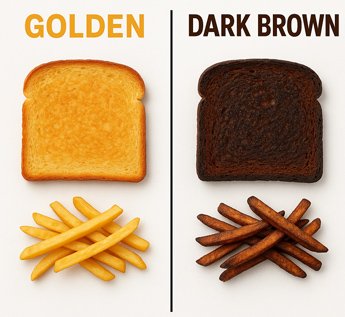Is the Burnt Area on Your Favorite Toast Healthy?
That crispy, dark-brown edge on your toast might seem tasty, but it is not the healthiest choice. When bread and other starchy foods are cooked at high temperatures — such as toasting, baking, or frying — they can form a chemical called acrylamide.

What is Acrylamide?
Acrylamide is a chemical that can form in plant-based, starchy foods like potatoes when they are cooked at high temperatures through frying, baking, or roasting. This compound develops when sugars react with the amino acid asparagine during the Maillard reaction, the same process that gives food its appealing golden-brown color.
Acrylamide is not typically associated with meat, dairy, or seafood products. Additionally, comparing frying, roasting, and baking these starch-rich foods, frying causes the highest acrylamide formation.
In what foods is acrylamide commonly found?
-
✅ Fried potatoes (French fries, potato chips).
-
✅ Toasted bread and baked goods.
-
✅ Coffee (from roasting coffee beans).
Why it matters:
High levels of acrylamide have been shown in animal studies to increase the risk of cancer. While evidence in humans is still being studied, health authorities, including the World Health Organization (WHO) and the U.S. FDA, recommend limiting acrylamide exposure by avoiding overcooking or heavily browning starchy foods.
According to the EFSA (European Food Safety Authority), the main toxicity risks of acrylamide are “Neurotoxicity, adverse effects on male reproduction, developmental toxicity and carcinogenicity”.
The problem is that the darker and more burnt the toast, the higher the acrylamide content. While occasional consumption is unlikely to cause serious harm, frequent intake may increase long-term health risks, including a potential link to cancer. Health experts recommend enjoying toast that’s light golden-brown rather than dark brown or blackened to reduce exposure.
Here are some practical tips to reduce acrylamide formation when cooking at home:
1. Control Cooking Time & Temperature-
- Avoid overcooking or heavily browning starchy foods like bread, potatoes, and pastries.
- Aim for a golden yellow color rather than dark brown when baking, roasting, or frying.
- Cook at the lowest temperature that still achieves the desired texture.
2. Handle Potatoes Properly-
- Don’t store raw potatoes in the refrigerator — cold storage increases sugar levels, which can boost acrylamide formation. Store them in a cool, dark, but not cold, place.
- Soak potato slices in water for 15–30 minutes before frying or roasting to remove some of the surface sugars.
- Blanching (brief boiling before frying) can also help reduce acrylamide.
3. Choose Cooking Methods Wisely-
- Boiling or steaming potatoes and vegetables does not produce acrylamide.
- For toast, lightly toast bread instead of dark toasting.
4. Be Mindful with Baked Goods-
- Avoid over-baking cookies, cakes, or biscuits — take them out once cooked through but before they get very dark.
5. Vary Your Diet-
- Eating a variety of foods lowers your overall exposure. Don’t rely heavily on fried or baked starchy snacks.
Read further on:
≺≺ How can I reduce the risk of cancer-causing chemicals when cooking or grilling meat?
≺≺ How toxic are the nitrites used in curing processed meats?
≺≺ What are the worst meats for accumulating cancer-causing chemicals during cooking?
≺≺ How are artificial sweeteners made?
≺≺ Can Physical Activity Help Improve My Arthritis?
≺≺ How common is thumb pain from too much texting?
≺≺ What health problems are linked to consuming corn syrup?
≺≺ What happens to my blood vessels when I gain weight?
≺≺ What are the four enemies of blood sugar?
≺≺ What type of exercise is best for lowering my blood sugar?
≺≺ What impact can sitting for long periods have on my health?
≺≺ Does my social circle impact my weight?
≺≺ How toxic are the nitrites used in curing processed meats?
≺≺ How can I reduce the risk of cancer-causing chemicals when cooking or grilling meat?
≺≺ What foods can lower prostate cancer risk?
≻≻ Watch this page for more such informative articles on Health, Nutrition, and Wellness.
≻≻-Back to Home page.
Further reading (External Links opens in new window):
≺≺- U.S. FDA- Acrylamide.
≺≺- W.H.O- Health implications of acrylamide in food.
≺≺- U.S. FDA- Acrylamide and Diet, Food Storage, and Food Preparation.

